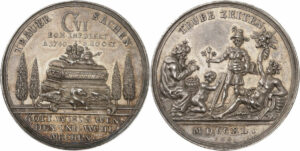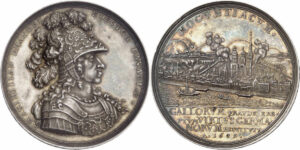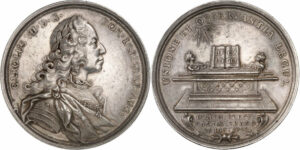
As part of the Beaury Collection, a rare gold medal will be auctioned off at Künker’s Spring Auction Sales 386. It depicts the Mainz Archbishop Philipp Karl von Eltz. We can only speculate as to why this magnificent medal of 10 ducats was created. Perhaps it was a diplomatic gift of grace for high dignitaries. But we do know that this medal was minted in a critical year of the 18th century, whose consequences threatened to shatter the balance of power in Europe. And Mainz was caught in the middle.
What Did the Artist Want to Tell Us?
But let us first take a look at the medal, after all, it shows a fascinating motif that is well worth analyzing. As many medals of the early modern period, it features an emblem on the reverse – a picture and a motto that jointly convey a message. We see a chariot wheel standing in a landscape with wind, sun and clouds. The circumscription can be roughly translated as “always steady despite the most diversified movements” or “always the same in different situations”.
It is a modern assumption to believe that such a depiction would have one singular meaning. At the time, people enjoyed the very fact that these images and texts could be interpreted in different ways and that they could show off their own erudition while discussing the matter with like-minded people. The chariot wheel makes all the difference: on the one hand, it can represent Mainz because the wheel is the coat of arms of the archdiocese. (There is a little flaw as the wheel of Mainz actually has only 6 spokes.) Therefore, the emblem can be interpreted like this: unimpressed by wind and weather, by events of any kind, the wheel, Mainz, the archbishop remains steadfast and true to their course. But the wheel is also the traditional symbol of fate, luck and the changeable nature of life. The Wheel of Fortune, as they said in the Middle Ages already, is always turning, those who just were up on top may be crushed under the wheel tomorrow. If we consider the wheel to represent fate, the wind that blows from the clouds could also be interpreted as divine guidance. The message is: it is God who moves the wheel and sets the course, and thus he directs the fate of the archdiocese.
It is probably nothing but a coincidence that the steadfastness of Mainz as proclaimed by this medal was put to the test within the same year of 1740. A conflict was in the offing in Europe.
No Son for the House of Habsburg
As was often the case at the time, problems arose due to the line of succession. It had been apparent for years that the male line of the Habsburgs was to die out. Emperor Charles VI only had daughters. Therefore, he did whatever he could to make the other European rulers accept his eldest daughter Maria Theresa as his heir – and her husband as emperor. For this reason, he also approached the Archbishop of Mainz, who is depicted on our medal. After all, Philipp Karl was not only one of the Electors who chose the emperor. He was also Imperial Archchancellor, i.e. the person responsible for organizing the election and the coronation of a new emperor. Philipp Karl von Eltz supported the Habsburg in his cause, and, in return, he and his family were granted significant benefits: a generous life annuity, the elevation to the rank of imperial count, and the possibility of acquiring land in today’s Croatia.

And then came 1740, the year in which our medal was minted. The Emperor passed away on 20 October, and the Imperial Archchancellor Philipp Karl initiated the preparations for the election of his successor. This was supposed to be Francis Stephen of Lorraine, the husband of Maria Theresa. But things turned out differently. Despite the late emperor’s careful arrangements, various states considered this a perfect opportunity to expand their territories at the expense of the weakened Habsburgs by asserting inheritance claims. The newly crowned Frederick II of Prussia began his bloody career and invaded Austrian Silesia. Saxony, Bavaria, Spain and France forged an alliance against Habsburg – the War of the Austrian Succession had begun. Elector Charles Albert of Bavaria seized the opportunity and, with the help of France, laid claim to the imperial crown, which the Habsburgs had held for over 300 years.

France at the Gates
And now, Philipp Karl von Eltz in Mainz was faced with a problem. Should he support the Habsburgs and oppose the new candidate as he had promised? Would his course remain steady despite the most diversified movements, as our medal had announced? There was an important point to be made against it: France. The expansive kingdom had long been a threat to Mainz. 51 years earlier, France had managed to conquer the city – a medal from Künker’s auction 386 with an impressive view of the besieged city bears testimony to this. Only a few years prior to 1740, French troops had threatened Mainz once again. So Philipp Karl von Eltz had better approach this matter with due caution. He first tried to mediate and vehemently supported Francis Stephen. But his efforts were in vain. Was his promise to a dead emperor really worth the risk of a French invasion? France’s threats became more blatant by the day and the archbishop decided: No.

The Wheel of Fortune Turns
Karl Philipp von Eltz reluctantly gave up his opposition and agreed to support Charles Albert of Bavaria. The latter was crowned emperor in Frankfurt on 14 January 1742 – however, not by the Mainz archbishop, as was tradition, but by the archbishop of Cologne. Eltz voluntarily waived this privilege. Why? Officially, because the archbishop of Cologne happened to be the brother of the new emperor. Eltz was probably quite relieved not to crown his involuntary change of course by crowning the new emperor himself. He died one year later at the age of 78.
Meanwhile, the Wheel of Fortune was still turning, as the newly crowned Emperor Charles VII quickly learned. Only two days after his triumphant coronation in Frankfurt, Austrian troops conquered Munich. The emperor had to live in exile in Frankfurt for a while. Three years later, the Wittelsbach had lost the imperial crown again. And the War of the Austrian Succession was anything but over.
All presented coins can be found in the current Künker auction catalog.
For more information visit the Künker website.
Read more about the medieval coins from Mainz.
Do you know Anselm Casimir – another famous man from Mainz?





